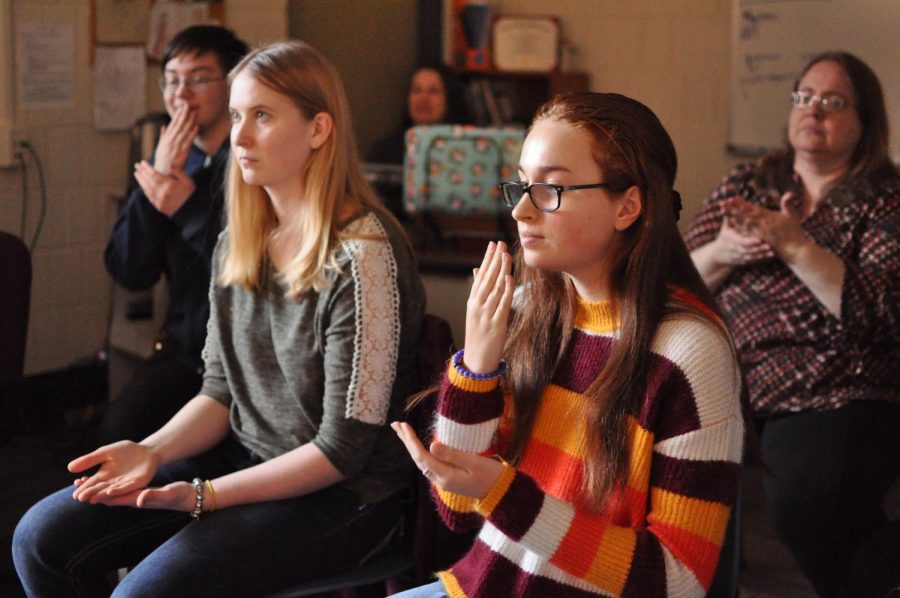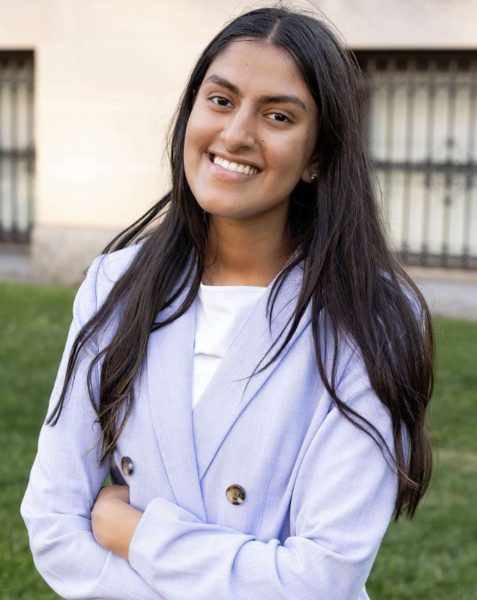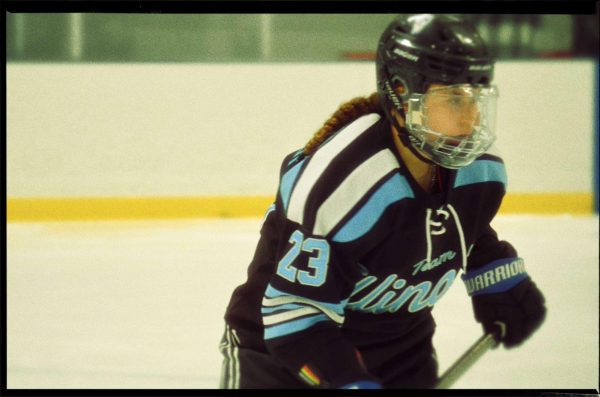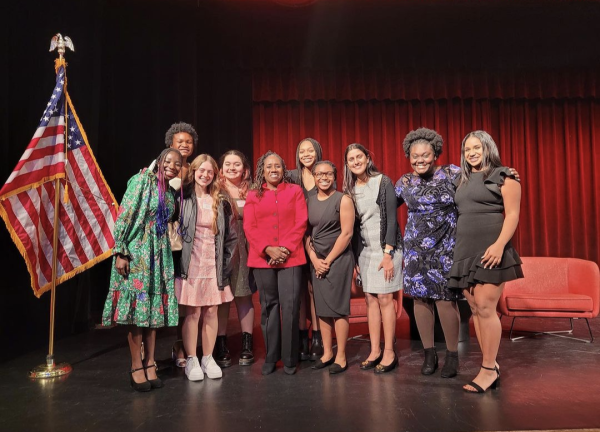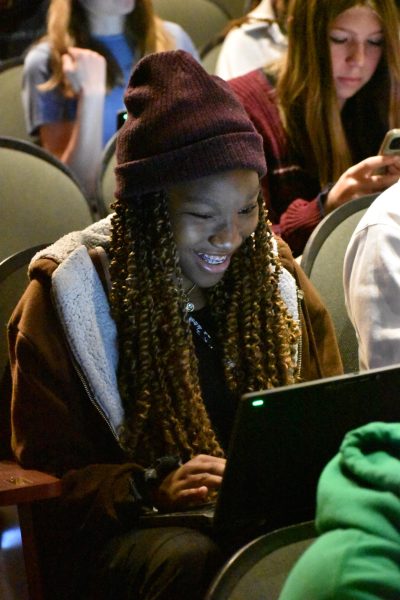Sign Club expands ways to connect
March 25, 2019
On February 13th, U-High had its inaugural Diversity Retreat where student representatives from every activity participated in various panels and listened to a keynote speaker, all in an effort to improve diversity mindset at U-High. One panel specifically focused on learning how to integrate students with vision and hearing loss in the classroom and in various social settings.
This specific panel was led by teacher of the Deaf and Hard of Hearing, Cora Colon, and vision teacher, Amy Lund. It was very hands on, to say the least. Students got to experience what it was like to be Blind by putting on blindfolds, or Deaf by putting on headphones that didn’t let any sound in. Then, they were asked to contribute to conversations, brainstorming ways to better integrate students with disabilities. Student response to this activity was incredibly positive.
At the end of the panel, Colon announced her invitation to Sign Language Club, a club that she sponsors on Tuesdays after school and Fridays during the 11:00 hour. The goal of this club is for hearing students to learn basic Sign Language and interact with Deaf and Hard of Hearing students to form new friendships.
Colon explained that there were a lot of people wanting to take a Sign Language class so she decided to start Sign Language Club.
“Deaf and Hard of Hearing students have experienced a passive rejection from other students, and I wanted to remove some of the fear and anxiety they face,” Colon said.
“Imagine going through an entire school day and there are only two or three other people that can communicate with you,” Colon said, “It really affects your psyche and you begin to think ‘am I worth the effort?’” Colon wanted to create an avenue for hearing students to reach out and “become a catalyst for a friendship.”
Among teenagers, when a student doesn’t have their license, they can ask their friend for a ride to the Friday night basketball game or or school play. But Colon described how her students have a lot more at stake. ““They are just like everyone else. They just can’t hear well, and that’s not a bad thing,” Colon said.
Wagher, who was previously in the Deaf and Hard of Hearing program at Metcalf, said that most people don’t know that he is Hard of Hearing. He can hear about a third of what is spoken around him, having lost 40 decibels of volume. “Normal conversation is about 60 decibels,” he explained.
“I miss a lot of words that are said in a conversation, and end up not knowing how to respond. Sometimes I hear every word but then miss the only word that matters,” Wagher said.
Wagher agrees with Colon about the need for inclusion.
“Most of the students at U-High are very accepting there’s just not a lot of awareness,” Wagher said. “They don’t know how to interact with Deaf or Hard of Hearing students, or how to ask ‘what can I do to make it easier for you to understand,’” 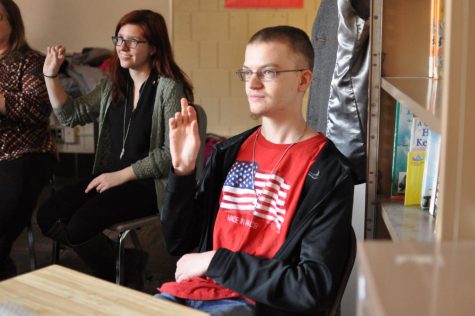
Part of Colon’s desire to be a teacher for the Deaf and Hard of Hearing stems from this desire to include. As a freshman in high school, she had the chance to take a crash course on Sign Language, and two years later, she utilized what she learned as a camp counselor.
There was a camper who had severe hearing loss, so she put her prior knowledge to use.
“Everyday I would make an effort to say good morning in Sign. By the end of the week, he would light up every time he saw me,” Colon said. “He felt like a normal kid, getting excited telling me how many fish he caught.”
This was when she knew she wanted to pursue this as a career. As she expressed with tears, “How silly was I to worry about how to communicate with someone when just trying means so much. My heart was moved,” Colon said.
She then pursued an education at Illinois State University as a teacher for the Deaf and Hard of Hearing, and felt affirmation in her decision as her tuition was waived. She had one particular instructor who was Deaf, and at first it was intimidating, not knowing how to communicate.
But this instructor inspired her, “She was so excited that people were going to try and impact kids who were like her,” Colon said.
Besides her experiences and the people who have impacted her, Colon’s ultimate motivation comes from her faith. According to an article written by Christianity Today, fewer than 7% of the Deaf community will have the opportunity to hear the gospel. This statistic overwhelmed Colon because she feels that everyone deserves to at least have the choice of faith, and most of the Deaf population doesn’t get that choice.
“Christianity is a huge part of my life, I rely on Jesus and know that I don’t have to be perfect,” Colon said.
Junior Esperanza Garcia is part of the Deaf and Hard of Hearing program at U-High. Deaf since birth, Garcia previously attended the Illinois School for the Deaf until two years ago. She explained that at this school, all of her teachers and classmates spoke Sign Language.
When she transferred to U-High, the environment changed.
“U-High is a school full of hearing people and I feel different.” Garcia said. “I struggle with interacting with people but I’ve learned how to adjust.” Not only in school, but in many environments communication can be difficult. “In large groups I don’t know who to follow and get overwhelmed during the conversations,”
Although Garcia explained the social struggles that come with being Deaf, she herself feels that she can handle herself in these situations. “I know how to communicate for myself I’m pretty independent.”
She encouraged hearing people that “there’s lots of different things Deaf people can understand” such as writing notes or other visual cues.
Garcia is a member of Sign Language Club, frequently attending and teaching as well. She and Colon have a strong relationship.
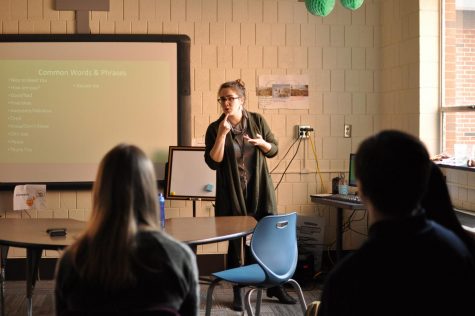 “Mrs. Colon makes me laugh,” Garcia said. When Colon first started Sign Language Club, Garcia wasn’t too sure about the idea.
“Mrs. Colon makes me laugh,” Garcia said. When Colon first started Sign Language Club, Garcia wasn’t too sure about the idea.
“Honestly, I was surprised at first because I didn’t expect U-High to accept Sign Language Club. I didn’t think anyone would come. Maybe hearing people don’t care about communicating with Deaf people,” Garcia said. Now, she is helping people learn Sign Language and finding enjoyment in it. “People learn to communicate with Deaf students at U-High and with people they come across in the future, too.” She sees value in the fact that students are developing a skill of communication to connect with people at U-High and also later in life.
One of Garcia’s first friends at U-High was senior Kate Humphrey. They were both in the same art class last year and Humphrey decided to reach out. Garcia explained that she was surprised when Humphrey first confronted her, but the new friendship sparked into something great. “We started off passing notes and she was curious to learn more Sign Language. She complimented my drawings and we shared an interest in art,” Garcia said.
Garcia described Humphrey as the first person that wanted to be her friend. If you know Kate Humphrey, this is not a surprise. Humphrey, the recipient of her Freshman class’ Freshman Program Award, is the president of GSA and known as a genuinely inclusive individual.
Humphrey also attended the Diversity Retreat in February and was very encouraged by the visual and hearing loss panel. “Now we can be a better advocate, ally, and friend,” Humphrey said.
Sign Language was part of Humphrey’s background prior to meeting Garcia and participating in Sign Language Club.
“I didn’t start speaking until a late age so I had to communicate with my mom through Sign Language. In middle school, I had a friend who had severe hearing loss, but our school did not have budget for a translator, so we both started learning Sign Language together. As a barista I encountered customers that were Deaf and I wanted to be able to serve them and their needs,” Humphrey said. With Sign Language, there are different signs for the same words and each individual might sign differently, so Humphrey likes to stay updated.
Both Humphrey and Garcia had some advice for starting a new friendship, despite the communication barrier. “You can pull out your notes app on your phone and just try to talk to them. It’s just pushing over the barrier of feeling uncomfortable,” Humphrey said.
This is a great way to start, but Garcia suggested a more meaningful way of interaction. “For Deaf people, expressing their own language is the best thing, hearing people can learn sign language, it’s not too hard.”
Garcia explained that a lot of people are afraid to talk to Deaf people, but confidence is the key. “It’s okay to make mistakes,” she said. Humphrey reiterated the same idea, “ We laugh and learn new signs from one another. Esperanza would correct me on signs that I got wrong. It’s not so hard once you get past the first hello.”
Cora Colon, Derek Wagher, Esperanza Garcia, and Kate Humphrey all reiterated the same idea: make an effort. The simple effort to open a conversation with ‘hello’ that can make a real difference.
“It’s our responsibility as U-High to promote a culture of equality, acceptance, and love. It’s okay to be a little uncomfortable sometimes because discomfort causes growth,” Colon said.
Come to Sign Language Club, at least try it out. Learn basic Sign Language and the alphabet, Tuesdays at 3 and Fridays at 11. The club meets for 30 minutes.
